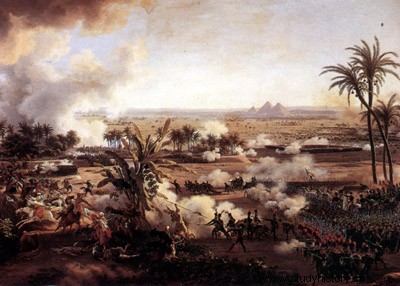
The Battle of the Pyramids takes place on 3 Thermidor Year VI (July 21, 1798) between the French Army of the East commanded by Bonaparte and the Mamluk forces commanded by Mourad Bey, during the Egyptian Campaign.
In July 1798, Bonaparte marched from Alexandria where he landed on July 1 in Cairo to occupy Egypt. A first combat, on July 13 at Chebreiss, ended in a rapid defeat of the Mamluks who lost 300 horsemen in this first combat. They then withdrew towards Cairo. Bonaparte is informed that Mourad Bey is waiting for him there with all his forces united. The Mamluks have indeed decided to fight a decisive battle under the walls of their capital. Their army, gathered on the left bank of the Nile around the village of Embabeh near the Giza plateau, is backed by the river, thus covering Cairo located on the right bank. Mourad Bey is at the head of more than 10,000 Mamluk horsemen, who stretch out into the plain between the river and the pyramids. These are accompanied by Arab horsemen and 24,000 fellahs and janissaries stationed in the village where rapid fortification works have been carried out.
The French army, which began its march at night, arrived at daybreak facing the enemy. It was then that Bonaparte was credited with this short harangue:
“Soldiers! You have come to these countries to rescue them from barbarism, bring civilization to the East, and save this beautiful part of the world from the yoke of England. We will fight. Remember that from the top of these monuments forty centuries are contemplating you. »
The French army is made up of five divisions as at Chebreiss. Desaix and Regnier commanded the right, made up of two divisions, Menou and Bon the left, also made up of two divisions. Bonaparte is in the center with the Kléber division commanded by Dugua in the absence of this general wounded in Alexandria.
Bonaparte put the army into squares of 2,000 men described thus by Thiers [
“Each division formed a square; each square was in six rows. Behind were the grenadier companies in platoon, ready to reinforce the points of attack. The artillery was at the angles; baggage and generals in the center. These squares were moving. When they were on the march, two sides marched on the flank. When they were loaded, they had to stop to face each other on all sides. Then, when they wanted to take a position, the first ranks had to break off to form attacking columns, and the others had to stay behind, still forming the square, but only three men deep, and ready to collect the attacking columns. 'offensive. »
The battle
Bonaparte, examining the enemy's device, noticed that the guns that guaranteed the Embabeh camp were not mounted on campaign carriages. He understands that the Turkish infantrymen will not dare to move away from it. He ordered Desaix to extend his right to put himself out of range of the artillery, and then to attack the Mamluks, while Bon, on his side, would attack the entrenchments of Embabeh in front, the aim of this maneuver being to place them between two fires and to separate the Mamluks from the entrenched camp.
Mourad notices the movement of the French and guesses the intention. He then gives the order to his cavalry to charge the French columns during their march. The shock is so rapid and brutal on the French columns, which are formed in squares, that they are shaken for a moment. The charges of the Mamluks multiply in vain in the face of the deluge of fire which falls on the horsemen. The discipline of the French squares seems to prevail over their disorderly efforts. Many Mamluks find death in front of these, where all their efforts are shattered. Bonaparte then seized this decisive moment to attack Embabeh. Generals Bon and Menou take the village and its entrenchments with bayonets, killing many Mamluks who are entrenched there. The Turkish division and the Fellahs are then tightened between the French squares and the river. They are entirely dispersed or destroyed. Mourad Bey, separated from his troops, withdrew towards Gizeh with 2,500 cavalry, the only remnant of his army, most of the Turkish troops and the Fellahs had saved themselves by swimming across the Nile. Desaix's division continues the pursuit beyond the pyramids.
Consequences
The French losses during this battle are very light, from 30 to 40 men dead and about 300 wounded against more than 20,000 killed or wounded as well as 40 guns for the Mamluks.
This battle opens the road to Cairo for Bonaparte, who enters there on July 24.
